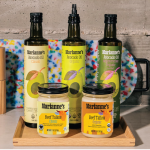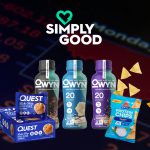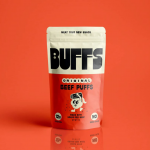To Cater to Values-Driven Shoppers, Companies Work to Quantify and Simplify Information on Food’s Climate Impact
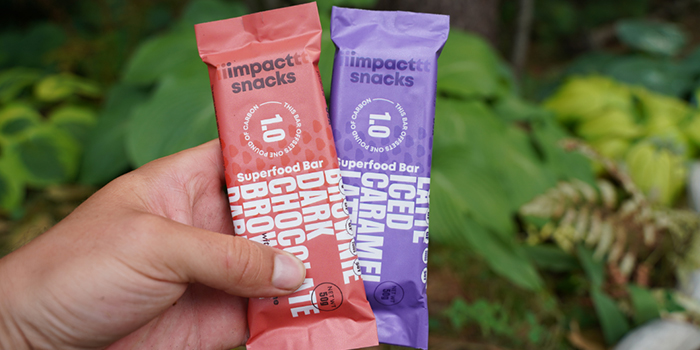
According to a 2019 report from the Intergovernmental Panel on Climate Change, the food system is responsible for about 21% to 37% of total greenhouse gas emissions — resulting from all parts of the production process from agriculture and land use to packaging, storage and transportation. Betting on consumers’ increased desire for transparency in the items they buy, some brands and marketplaces are working to help educate shoppers about the carbon impact of their purchases, providing clarity to a previously opaque part of the industry. From sharing the carbon footprint of a product’s life cycle to offering credits to offset these emissions, these companies are working to meaningfully quantify this impact for consumers, hoping that simplifying the process of sustainable shopping can have a real impact on their choices.
As bets go, it would seem to have some takers: consumer interest in sustainable products is on the rise, with the growth of sustainably marketed products outpacing the growth in 90% of their respective categories. From cookies to crackers to frozen dinner entrees, these products are the “key to winning” with millennials and Generation Z particularly, said Larry Levin, EVP of market and shopper intelligence at IRI in its “The State of Sustainability in CPG” report released this summer.
There have certainly been other sustainability pushes in the past, but brands believe that consumers are now showing more interest in their carbon impact because the numbers are there: it’s a quantifiable metric amidst an array of other sustainability plays that are not measurable. These metrics have also empowered brands themselves to make changes. Armed with actual data they can use, mission driven companies are able to identify ways to compensate for this impact and create concrete plans for offsetting their carbon footprint, resulting in both brands and retailers developing new marketing and operational tactics.
Crafting Products With Carbon Impact in Mind
To-date, brands have largely placed the responsibility to offset carbon emissions on consumers themselves. But why? The companies themselves are responsible for the bulk of carbon emissions, muses Corey Nobile, co-founder of Gen-Z founded sustainable CPG food brand Impact Snacks.
“Whenever a brand needs to talk to a consumer about what they should all be doing, it can never be in the context of the consumer is wrong because, remember, the consumer is just shopping with the products that they’re presented with,” Nobile said. “They don’t have a manufacturing facility in their basement, right? So if the entire landscape is built with this broken system, they have no choice.”
Created with the goal to make a single-use product that was still sustainable and transparent about its impact, Impact Snacks also reflects the cost of sustainability in its price structure.
With the help of its “carbon accountants” at carbon offset company Clearloop, the brand determined each of its bars creates 0.38 pounds of carbon when produced and shipped. The brand offsets one pound of carbon per bar through investments in new solar projects, making the products 250% carbon negative. The brand also has a sliding price scale for its products, allowing consumers to choose a price per bar of $2.25 to $3.75 to make shopping sustainably more accessible to a wider range of consumers.
The brand rolled out two flavors of its plant-based superfood bars in September, each packaged in home-compostable, certified marine-biodegradable wrappers.
Other brands, like Oatly and Quorn, are making moves to show their impacts through carbon labels. Oatly has carbon labels on its European product packaging as well as online, and a representative for the brand confirmed it is aiming to make these labels available on a global level. In its sustainability report released last week, the brand claimed it believed “climate footprint labeling should be the law” and urged other companies to join a campaign it started last year called “Hey Food Industry, Show Us Your Numbers.”
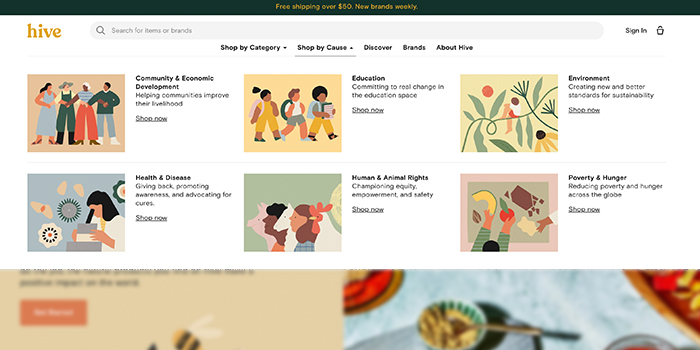
Creating a Transparent Marketplace
Even for products that are addressing their carbon impact, it’s often still difficult for environmentally conscious consumers to find them. Hive, a new online values-driven food and beverage marketplace launched last month, aims to make that process easier. The marketplace curates brands by cause, allowing consumers to shop brands committed to improving education, reducing poverty or creating better standards for sustainability. Hive purports to be a one-stop shop for brands that are transparent about their impact, said Katie Tyson, co-founder and Chief Commercial Officer at Hive.
“Consumers are in many cases, cross shopping across many different platforms, and really trying to make heads or tails of what actually makes a product better versus when a brand is just saying that they’re doing better,” Tyson said.
Hive has a five-point vetting criteria for products sold on the site, said co-founder and CEO Thomas Ellis. Each product listing breaks down some of a brand’s particular strengths. For example, chocolate brand Alter Eco has been carbon neutral since 2009, which is implemented through carbon offsetting projects within its supply chain.
At checkout, consumers can see the carbon footprint of their purchase (measured in pounds), offset through Hive’s partnership with Cloverly, which calculates and buys carbon offsets to neutralize the impact of processes such as ecommerce shipping. The carbon offset projects are as close geographically to the purchaser as possible, like a wind farm in Maine or a solar project in Utah, said Hive’s head of sustainability Jamie Leidelmeyer.
Helping Consumers Understand Their Impact
While many consumers support the broad concept of “sustainability,” even the most environmentally conscious consumers don’t necessarily understand what kilograms or cubic meters of carbon actually mean. Grocery shopping app Green Choice seeks to quantify this data in ways that consumers can better understand by breaking down the nutritional value, health considerations and sustainability characteristics of grocery items, giving each item a score out of 100.
The app then identifies brands’ carbon footprint on a scale from low to extremely high, and quantifies the metric tons of carbon output by communicating it as equivalent to a certain number of miles driven in a car. Green Choice founder and CEO Galen Karlan-Mason said this method helps to “anchor [a consumer’s] understanding of the actual impact of the product,” providing a benchmark to measure a quantity of carbon that might otherwise be lost on them.

Though it also quantifies data, comparing its carbon emissions to trips in a car or plane, Impact Snacks has found a different approach to communicate climate impact data to its younger consumers: memes. The brand uses its Instagram account to share information about topics such as shipping pollutants, single-use plastics, and the way plant-based eating can reduce your carbon footprint, breaching topics that are often heavy and complex in “a way that everyone understands,” Nobile said.
“These [climate] problems look so massive, and it can seem almost hopeless,” Nobile said. “So when you can highlight little positive things, or little factoids by telling a joke, we’ve just seen our raw engagement go way up.”
The Path Forward
Green Choice is now working on developing a function on its app that allows customers to filter products by an even more exacting level of transparency, identifying companies whose reported sustainability metrics are verified by a third party. Karlan-Mason said the majority of brands currently do not disclose the carbon footprints of their products and the app’s team must calculate the footprint itself. By highlighting brands that are doing the work themselves, the team hopes to show brands that sustainability metrics can be a marketing tool on their own merit.
But if carbon labels are a step in the right direction in terms of brand transparency, both Nobile and Leidelmeyer also believe brands must take steps beyond just publishing their numbers if they want to see a change in how consumers actually shop.
“I think there’s a lot more work to be done to truly see a behavior change in a consumer base, Leidelmeyer said. “If you pair that with educational campaigns, pair that with more resources, that can actually make that number mean something in their head.”
Nobile said being transparent about carbon footprints and other climate data should just be a part of brands’ sustainability efforts and ultimately hopes to inspire other brands to take concrete action to reduce or offset emissions by demonstrating how simple and beneficial this process can be.
“The technology needed to make a better supply chain today exists, there’s just this weird disconnect that some people have, where they think that sustainability just means expense or losing money,” Nobile said. “When the reality couldn’t be further from it. It’s only going to increase brand loyalty and profitability, if that was your goal to begin with.”


